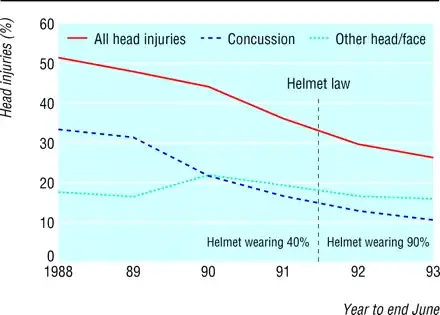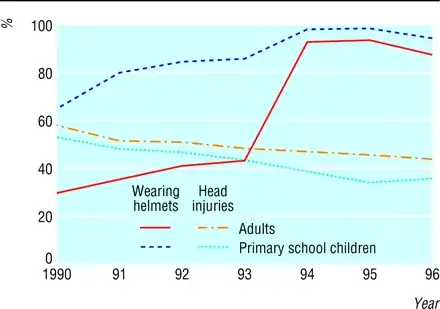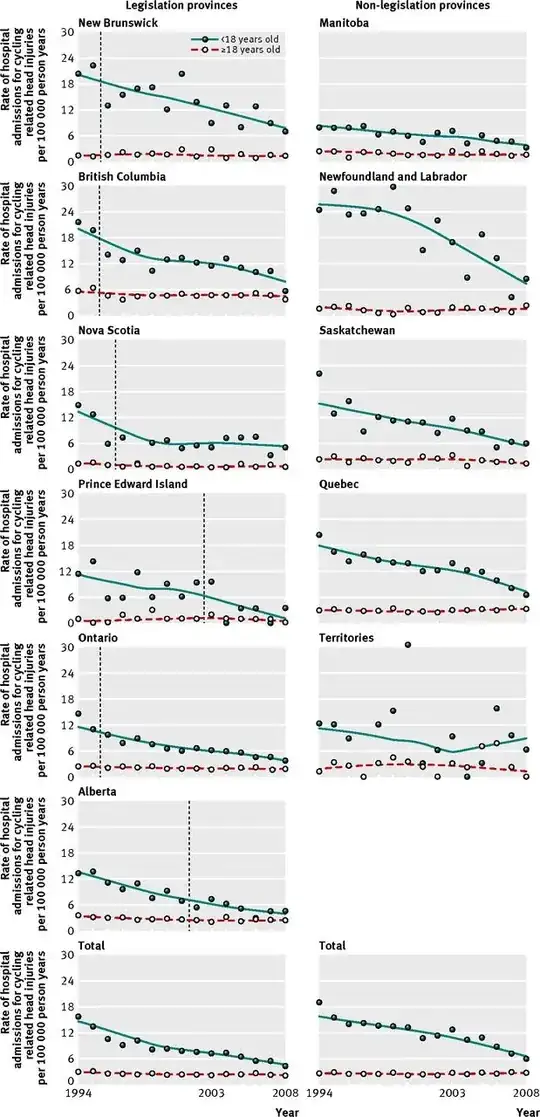Many of the frequently quoted statistics don't convincingly show a protective affect from helmets.
Cycling is an inherently safe activity where serious accidents are rare. This makes it harder to judge the effectiveness of safety interventions. Small behavioural changes can add significantly to the rate of accidents and confounding factors can easily sway the results. Care is required when drawing conclusions form the reported statistics.
There are, in principle, several ways for the reported statistics to go astray.
If we compare accidents (eg by hospital admissions) for helmet wearing and non-wearing groups we need to be sure the groups are comparable. If helmet wearers are significantly different (eg very safety conscious) some of the apparent protective effects may come from their (unrelated) risk aversion and not actually from helmets.
If helmets are worn by most people (usually because they are mandatory) then we no longer have a (useful) control group of non-wearers. And we have the possibility of risk compensation (where behaviour becomes riskier because the users feel safer). The extent of risk compensation is impossible to judge reliably in either sample.
If we bear these observations in mind we can assess the value of published studies.
Some studies are very weak. This BMJ report from 2000 argued that:
The number of serious head injuries among cyclists fell
markedly during a period of increasing helmet use,
suggesting that helmets offer protection.
No proper comparisons for different groups and correlation=causation assumed.
This much better study published in the BMJ in 1994 is typical of case control studies in that it compares injuries in those wearing helmets to those not wearing them, concluding:
There were no significant differences between the two groups with respect to type of accident or nature and distribution of injuries other than those to the head. Head injury was sustained by 4/114 (4%) of helmet wearers compared with 100/928 (11%) of non-wearers (P=0.023).
This is a much more robust result. But statistically suffers from the problem of confounding. We just can't know whether the people choosing to wear helmets behave like those who don't. The very choice to wear might suggest not, though some of the more detailed statistics in the paper might draw the opposite conclusion.
One critic writing in the BMJ summed up the problem with one study thus:
the study's serious flaw was that it did not
discount the possibility that the cyclists with head
injuries were very different from those with other
injuries. An observational study in the same city
showed that children wearing helmets were much more
often white than black, riding in parks and on bicycle
paths than on city streets, and riding with adults rather
than riding alone.' Without proper matching for risk
taking behaviour, the hospital study is useless as policy
Thought his point was specific, the problems he highlights may ocurr in all case-control studies.
If the protective effect of helmets that is derived from the case-control studies is right, we would expect to see big changes in head injuries when helmet use becomes very common or compulsory. This is where it gets controversial. Those population studies have been done and frequently don't show the expected gains in injury prevention.
This BMJ review in 2006 summarised much of the evidence like this:
I reviewed data from all jurisdictions that have introduced legislation and increased use of helmets by at least 40 percentage points within a few months: New Zealand, Nova Scotia (Canada), and the Australian states of Victoria, New South Wales, South Australia, and Western Australia. To avoid confusing reductions in injuries (from safer roads or less cycling) with benefits of helmets, I have focused on percentages of cyclists with head injuries. Head injuries were most commonly classified as admissions to hospital with head wounds, skull or facial fracture, concussion, or other intracranial injury. The data include 10 504 head injuries, and in most cases were available as percentages of all cyclist injuries.
and concluded (my emphasis):
In contrast to the fall in all road injuries in South Australia coinciding with helmet legislation, percentages of cyclists with concussion and other head or face injuries show generally declining trends, especially for concussion, but no clear response when helmet wearing increased substantially
Here is the chart of the data from Western Australia

Similar evidence from South Australia:

and New Zealand:

Overall conclusion:
Case-control studies suggest cyclists who choose to wear helmets generally have fewer head injuries than non-wearers
Before and after data show enforced helmet laws discourage cycling but produce no obvious response in percentage of head injuries
This contradiction may be due to risk compensation, incorrect helmet wearing, reduced safety in numbers, or incorrect adjustment for confounders in case-control studies
It is only fair to note this is a highly controversial conclusion (see the BMJ discussion).
The reason why the studies about what happens when most people wear helmets is relevant to the question of whether helmets protect the individual helmet wearer is simply that they represent the only studies where the sample avoids confounding errors and takes into account any risk adjustment. We know there is some degree of risk adjustment (see this Skeptics question: Do cars pass with less space for bicyclists who wear helmets?) but we can only know the significance of that adjustment from a population study.
I'd say that, despite their intuitive benefits helmets provide, the population studies cast enough doubt on the theory advocated by the case-control studies that we cannot be certain helmets give a significant benefit to the user.
Update
A recent (feb 2013) study from the National Bureau of Economic Research (pdf here) looked at the effect of laws on childrens' cycling accidents and behavior. The study showed a significant reduction in injuries associated with the laws but tried to examine some of the effects of confounding. They conclude (my emphasis):
Cycling is popular among children, but results in thousands of injuries annually. In recent years, many
states and localities have enacted bicycle helmet laws. We examine direct and indirect effects of these
laws on injuries... ...we find helmet laws
are associated with reductions in bicycle-related head injuries among children. However, laws also
are associated with decreases in non-head cycling injuries, as well as increases in head injuries from
other wheeled sports. Thus, the observed reduction in bicycle-related head injuries may be due to
reductions in bicycle riding induced by the laws.
And:
The findings from this paper indicate that while bicycle helmet laws are widespread and
thought to be effective, the net effect of these laws on health outcomes is actually not straightforward. It is clear that there are offsetting behaviors and unintended consequences of these laws, and these effects need to be considered by policymakers.
In short, the apparent success of compulsory helmet laws may not result from the protective effects of helmets from from the (unintended) effect of discouraging cycling. It isn't that helmets protect the cyclist. Public health may well, therefore, not benefit from such laws.
Update 2
A recent study of the effect of the range of different Canadian helmet laws on head injuries was recently published in the British Medical Journal (BMJ). this paper took into account injury trends pre and post legislation and used the variety of different rules or the lack of them across different canadian provinces to provide useful comparisons. While the study doesn't assess all the possible confounding factors, the results are fairly clear: legislation doesn't seem to have a significant effect.
It is worth quoting the results and conclusions in their entirely for context (my emphasis):
Results Between 1994 and 2008, 66 716 hospital admissions were for cycling related injuries in Canada. Between 1994 and 2003, the rate of head injuries among young people decreased by 54.0% (95% confidence interval 48.2% to 59.8%) in provinces with helmet legislation compared with 33.1% (23.3% to 42.9%) in provinces and territories without legislation. Among adults, the rate of head injuries decreased by 26.0% (16.0% to 36.3%) in provinces with legislation but remained constant in provinces and territories without legislation. After taking baseline trends into consideration, however, we were unable to detect an independent effect of legislation on the rate of hospital admissions for cycling related head injuries.
Conclusions Reductions in the rates of admissions to hospital for cycling related head injuries were greater in provinces with helmet legislation, but injury rates were already decreasing before the implementation of legislation and the rate of decline was not appreciably altered on introduction of legislation. While helmets reduce the risk of head injuries and we encourage their use, in the Canadian context of existing safety campaigns, improvements to the cycling infrastructure, and the passive uptake of helmets, the incremental contribution of provincial helmet legislation to reduce hospital admissions for head injuries seems to have been minimal.
Some of the core data is summarised in the charts below:

Annual rate of hospital admissions for cycling related head injuries, 1994 to 2008, in Canadian provinces and territories, and in Canadian provinces and territories grouped by bicycle helmet legislation status. Rates are connected by a LOESS regression line. Vertical bars indicate year legislation was enacted. Legislation in Ontario and Alberta targeted only cyclists aged less than 18 years.
In short: cycling injuries are reducing but detailed analysis of the statistics doesn't show that legislation independently contributes to that improvement. While the study is addressing the effect of legislation not helmet wearing it also notes:
Laws that mandate the use of helmets increase the chance that cyclists will wear a helmet, especially when they apply to all cyclists...
...helmet use rose dramatically in provinces immediately after the enactment of legislation...
So, though indirectly, it lends support to the idea that increased helmet use is much less helpful than expected.



